
Alessandro di Mariano di Vanni Filipepi, known as Sandro Botticelli, was an Italian painter of the Early Renaissance. Botticelli's posthumous reputation suffered until the late 19th century, when he was rediscovered by the Pre-Raphaelites who stimulated a reappraisal of his work. Since then, his paintings have been seen to represent the linear grace of late Italian Gothic and some Early Renaissance painting, even though they date from the latter half of the Italian Renaissance period.

Filippino Lippi was an Italian painter working in Florence, Italy during the later years of the Early Renaissance and first few years of the High Renaissance.
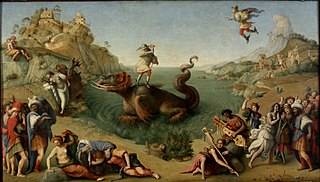
Piero di Cosimo, also known as Piero di Lorenzo, was an Italian painter of the Renaissance.
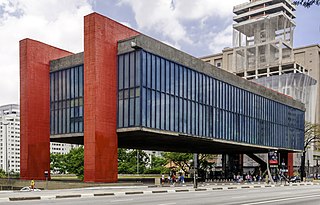
The São Paulo Museum of Art is an art museum located on Paulista Avenue in the city of São Paulo, Brazil. It is well known for its headquarters, a 1968 concrete and glass structure designed by Lina Bo Bardi, whose main body is supported by two lateral beams over a 74 metres (243 ft) freestanding space. It is considered a landmark of the city and a main symbol of modern Brazilian architecture.

Lina Bo Bardi, born Achillina Bo, was an Italian-born Brazilian modernist architect. A prolific architect and designer, she devoted her working life, most of it spent in Brazil, to promoting the social and cultural potential of architecture and design. While she studied under radical Italian architects, she quickly became intrigued with Brazilian vernacular design and how it could influence a modern Brazilian architecture. During her lifetime it was difficult to be accepted among the local Brazilian architects, because she was both a "foreigner" and a woman.
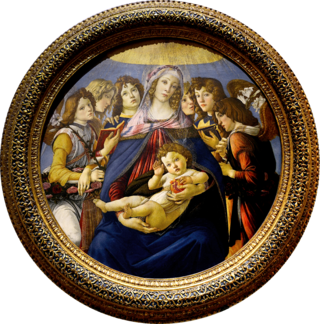
The Madonna of the Pomegranate was painted in circa 1487 with tempera on a wood panel by Sandro Botticelli. It is now in the Uffizi in Florence. Sandro Botticelli was a leading Italian Renaissance artist from Florence, Italy. The Madonna (art) uses the circular format, better known as a tondo, which focuses the attention on the main characters, the Virgin Mary and baby Jesus, who are surrounded symmetrically by angels on each side. Botticelli's use of tempera grassa give the characters a real look, better known as a "naturalistic" style, which is common during the Renaissance. The Virgin Mary is holding baby Jesus gently in her arms while holding a pomegranate in her left hand.

Madonna in Glory with Seraphim is a painting by the Italian Renaissance painter Sandro Botticelli, executed c. 1469–1470. It is housed in Galleria degli Uffizi.
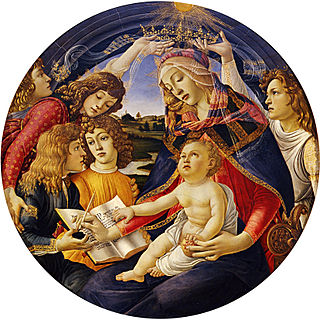
The Madonna of the Magnificat, is a painting of circular or tondo form by the Italian Renaissance painter Sandro Botticelli. It is also referred to as the Virgin and Child with Five Angels. In the tondo, we see the Virgin Mary writing the Magnificat with her right hand, with a pomegranate in her left, as two angels crown her with the Christ child on her lap. It is now in the galleries of the Uffizi, in Florence.
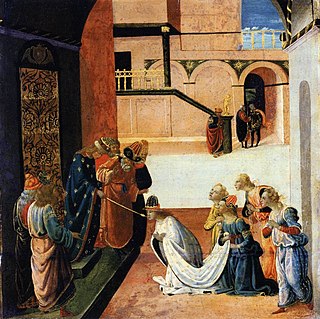
Jacopo del Sellaio (1441/42–1493), was an Italian painter of the early Renaissance, active in his native Florence. His real name was Jacopo di Arcangelo. He worked in an eclectic style based on those of Botticelli, Filippino Lippi, and Domenico Ghirlandaio. The nickname Sellaio derives from the profession of his father, a saddle maker.

Madonna Adoring the Child with Five Angels is a tondo or round painting by the Italian Renaissance master Sandro Botticelli, completed between 1485 and 1490. It is housed in the Baltimore Museum of Art, in Baltimore, Maryland.
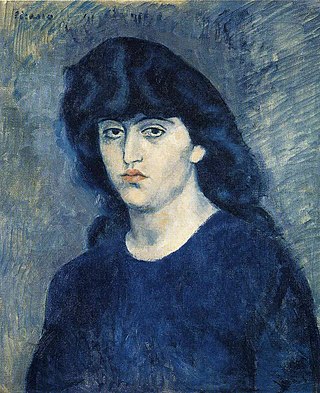
Portrait of Suzanne Bloch is an oil on canvas painting executed by the Spanish artist Pablo Picasso in Paris in 1904, towards the end of his Blue Period. The subject, Suzanne Bloch, was a singer known for her Wagner interpretations, and the sister of the violinist Henri Bloch. The painting is housed in the São Paulo Museum of Art.

The Resurrection of Christ (1499–1502), also called The Kinnaird Resurrection, is an oil painting on wood by the Italian High Renaissance master Raphael. The work is one of the earliest known paintings by the artist, executed between 1499 and 1502. It is probably a piece of an unknown predella, though it has been suggested that the painting could be one of the remaining works of the Baronci altarpiece, Raphael's first recorded commission. The painting is now in the São Paulo Museum of Art.
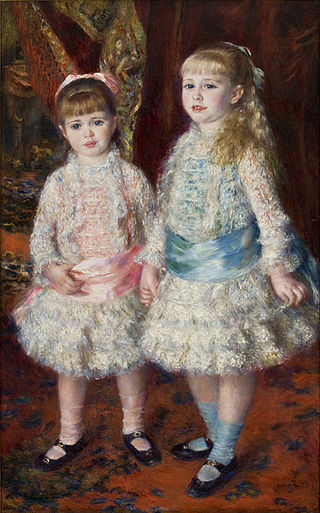
Alice and Elisabeth Cahen d’Anvers is an oil painting by French impressionist Pierre-Auguste Renoir. Produced in Paris in 1881, the painting depicts the sisters Alice and Elisabeth, daughters of Louise Cahen d'Anvers and her husband the Jewish banker Louis Raphaël Cahen d'Anvers. It is considered one of the most popular works in the collection of the São Paulo Museum of Art, where it has been conserved since 1952.

Gretta Sarfaty, born Alegre Sarfaty, is also known as Gretta Grzywacz and Greta Sarfaty Marchant, also simply as Gretta. is a painter, photographer and multimedia artist who earned international acclaim in the 1970s, from her artistic works related to Body art and Feminism. Born in Greece, in 1947, she moved with her family to São Paulo in 1954, being naturalized as Brazilian.
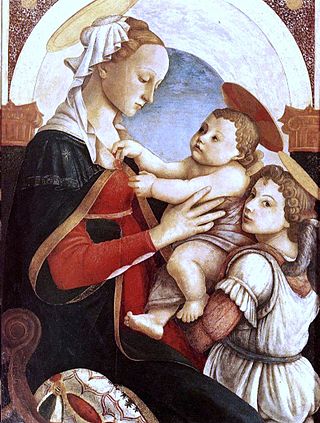
The Madonna and Child with an Angel is a painting by the Italian Renaissance painter Sandro Botticelli, c. 1465–1467. It is housed in Spedale degli Innocenti of Florence.
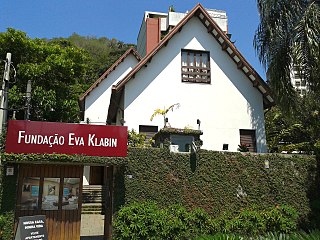
The Eva Klabin House Museum is an historic house museum located in the city of Rio de Janeiro, Brazil. It is a private institution established in 1990 by the Brazilian collector and philanthropist Eva Klabin (1903–1991), with the purpose of preserving and displaying the art collection gathered together during her life. The collection is open to the public in the house where Klabin lived for over thirty years. It is considered one of the largest classical art collections in Brazilian museums, with over 2000 works spanning almost 5000 years, from Ancient Egypt to Impressionism.

Portrait of a Young Man with a Gold Chain is an oil painting usually attributed to the Dutch painter Rembrandt. Signed and dated 1635, it was traditionally regarded as a self-portrait, although contemporary criticism tends to challenge this hypothesis.
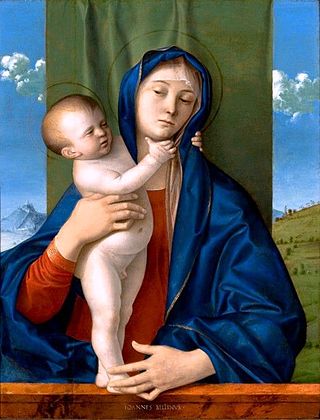
Virgin with the Standing Child, Embracing his Mother, also known as Willys Madonna is a painting by the Italian Renaissance master Giovanni Bellini. It is now in the São Paulo Museum of Art in São Paulo, Brazil.
Judith Lauand was a Brazilian painter and printmaker. She is considered a pioneer of the Brazilian modernist movement that started in the 1950s, and was the only female member of the concrete art movement based in São Paulo, the Grupo Ruptura.
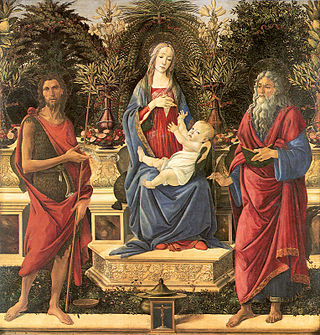
The Bardi Madonna or Madonna and Child with Saint John the Baptist and Saint John the Evangelist is a 1480s tempera on panel painting by Sandro Botticelli, now in the Gemäldegalerie, Berlin. Its primary name derives from the rich Florentine banker Agnolo Bardi who commissioned it for his family chapel at the Santo Spirito Basilica in Florence. It was completed around the end of 1485.




















